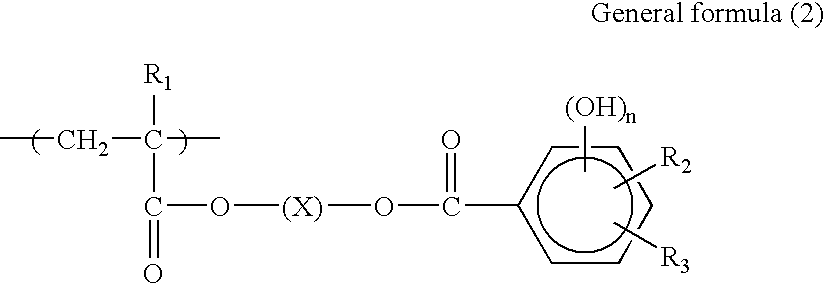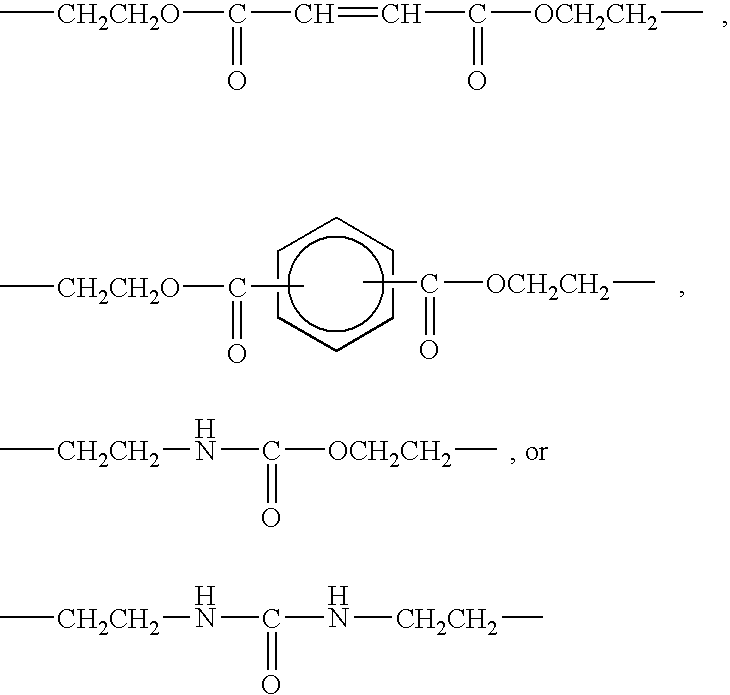Polymerizable composition and negative-working planographic printing plate precursor using the same
a technology of composition and negative working plan, applied in the direction of lithography, photosensitive materials, instruments, etc., can solve the problems of poor printing endurance, low adhesion at the interface between the recording layer and the support, and deterioration of printing endurance, so as to suppress the penetration of alkaline developing solution, the effect of reducing the damage caused by the penetration of developing solution into the recording layer
- Summary
- Abstract
- Description
- Claims
- Application Information
AI Technical Summary
Benefits of technology
Problems solved by technology
Method used
Image
Examples
synthesis example 1
Synthesis of High-Molecular Compound (1)
[0104]In a 500-mL three-necked flask equipped with a condenser and a stirrer, 240 mL of dimethylacetamide was charged and heated at 70° C. A dimethylacetamide solution (240 mL) containing 33.9 g of a precursor monomer having a structural unit containing a radical addition polymerizable group (Compound M-1 described below), 20.5 g of methyl methacrylate, 36.3 g of Illustrative Compound (A-8) and 0.690 g of an azo heat polymerization initiator (a trade name: V-65, manufactured by Wako Pure Chemical Industries, Ltd.) was added dropwise thereto over 2.5 hours in a nitrogen gas stream. The mixture was allowed to react at 70° C. for 2 hours. After cooling the reaction mixture to 0° C., 38.9 g of triethylamine was added dropwise thereto with stirring, and the mixture was allowed to react for 15 hours while gradually elevating the temperature to room temperature. After cooling the reaction mixture to 0° C., 3M HCl was added dropwise thereto with stirr...
synthesis example 2
Synthesis of High-Molecular Compound (4)
[0106]In a 2,000-mL three-necked flask equipped with a condenser and a stirrer. 750 g of dimethylacetamide was charged and heated at 70° C. A dimethylacetamide solution (750 g) containing 32.2 g of allyl methacrylate, 74.3 g of Illustrative Compound (E-7), 4.2 g of methyl methacrylate and 0.679 g of an azo heat polymerization initiator (a trade name: V-59, manufactured by Wako Pure Chemical Industries. Ltd.) was added dropwise thereto over 2.5 hours in a nitrogen gas stream. The mixture was allowed to react at 70° C. for 2 hours. After cooling the reaction mixture to room temperature, the reaction mixture was thrown into 4 L of water to deposit a polymer. The polymer was collected by filtration, rinsed and then dried to obtain 100 g of High-Molecular Compound (4). As a result of gel permeation chromatography (GPC) using polystyrene as a standard substance, this compound had a weight average molecular weight of 115,000.
synthesis examples 3 to 18
Syntheses of High-Molecular Compounds (2), (3) and (5) to (18)
[0107]High-Molecular Compounds (2), (3) and (5) to (18) were synthesized in the same manners as in Synthesis Examples 1 and 2 while changing the kinds of monomers to be charged and composition ratios. These compounds were measured for weight average molecular weight in the same manners as in Synthesis Examples 1 and 2.
[0108]The high-molecular compounds (specific binder polymers) obtained in the foregoing synthesis methods are shown in the following Tables 1 to 4 with respect to structures and polymerization molar ratios of the structural units thereof along with their weight average molecular weights measured (High-Molecular Compounds (1) to (18)).
[0109]
TABLE 1Syn. No.Composition (% by mole)Mw1205,0002123,0003 78,0004115,0005152,000
[0110]
TABLE 2Syn. No.Composition (% by mole)Mw6142,0007 95,0008104,0009 75,00010153,00011135,000
[0111]
TABLE 3Syn. No.Composition (% by mole)Mw12179,00013153,00014143,00015154,00016175,000
[0112]...
PUM
| Property | Measurement | Unit |
|---|---|---|
| Nanoscale particle size | aaaaa | aaaaa |
| Nanoscale particle size | aaaaa | aaaaa |
| Percent by mole | aaaaa | aaaaa |
Abstract
Description
Claims
Application Information
 Login to View More
Login to View More - R&D
- Intellectual Property
- Life Sciences
- Materials
- Tech Scout
- Unparalleled Data Quality
- Higher Quality Content
- 60% Fewer Hallucinations
Browse by: Latest US Patents, China's latest patents, Technical Efficacy Thesaurus, Application Domain, Technology Topic, Popular Technical Reports.
© 2025 PatSnap. All rights reserved.Legal|Privacy policy|Modern Slavery Act Transparency Statement|Sitemap|About US| Contact US: help@patsnap.com



